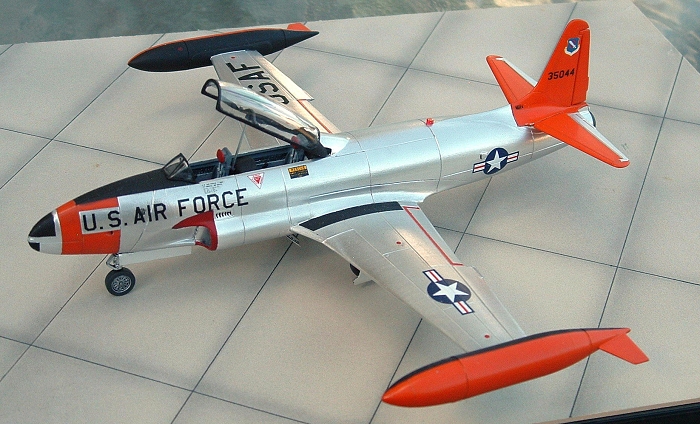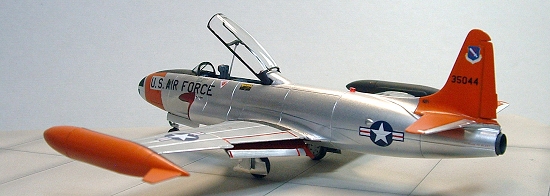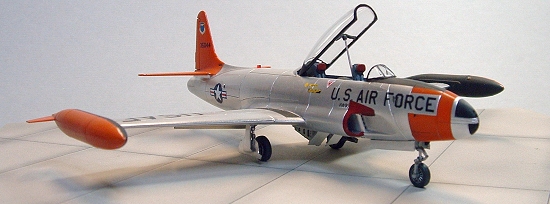
Heller 1/72 T-33A Shooting Star
| KIT #: | ? |
| PRICE: | around $10.00 when new |
| DECALS: | two options |
| REVIEWER: | Chuck Holte |
| NOTES: |

| HISTORY |
For some reason, I have a hard time starting a new “state of the art” kit, even though I have a basement full of them. Maybe it’s the high price of the new kits and a subliminal fear of screwing-up something expensive. Or maybe my skills aren’t up to modern technology. Or maybe I’m searching for old memories. At any rate, I often find myself going back to the stash of “old” kits.
| THE KIT |
This time I took on the venerable Heller RT/T-33 in 1/72 scale. The kit dates to the early ‘80s and is a considerable improvement over the Hasegawa kit of ten or more years earlier.
 Heller issued their kit in at least two
different boxes (both numbered 80301) with different decals but the same
plastic. The USAF Thunderbird T-33 kit includes decals for a French AF
RT-33 from the 33rd Reconnaissance Squadron and the other kit
has decals for a French T-33 from GE 314 and a Dutch RT-33 from 306
Squadron. Both kits include the optional photo nose and a rack of
equipment boxes to install in the rear cockpit instead of the seat. I
wanted a standard T-Bird so I didn’t use the photo nose. For something a
little different, the unused photo nose could be combined with the Airfix
F-80 kit for a relatively simple conversion to a RF-80A.
Heller issued their kit in at least two
different boxes (both numbered 80301) with different decals but the same
plastic. The USAF Thunderbird T-33 kit includes decals for a French AF
RT-33 from the 33rd Reconnaissance Squadron and the other kit
has decals for a French T-33 from GE 314 and a Dutch RT-33 from 306
Squadron. Both kits include the optional photo nose and a rack of
equipment boxes to install in the rear cockpit instead of the seat. I
wanted a standard T-Bird so I didn’t use the photo nose. For something a
little different, the unused photo nose could be combined with the Airfix
F-80 kit for a relatively simple conversion to a RF-80A.
The parts are typical of the early
‘80s. The cockpit tub is adequate but could use a bit more detail. Front
and back instrument panels have some raised detail and will require
delicate painting or replacement with brass bits (Airwaves # 2107, Eduard
#72145). Ejection seats are pretty basic but True Details has a nice set
of resin seats (# 72405). The canopy
 is a one-piece affair and a bit on
the thick side. I scribed the panel lines using the raised panel detail as
a guide. I cut out the inboard lower flaps so they could be displayed in
the open position, typical of a T-Bird on the ground. I suggest scribing
the panel lines on the wings before assembly, it’s a lot easier. The
landing gear and wheels are satisfactory, but there is no gear well
detail.
is a one-piece affair and a bit on
the thick side. I scribed the panel lines using the raised panel detail as
a guide. I cut out the inboard lower flaps so they could be displayed in
the open position, typical of a T-Bird on the ground. I suggest scribing
the panel lines on the wings before assembly, it’s a lot easier. The
landing gear and wheels are satisfactory, but there is no gear well
detail.
A few words about the Eduard brass set for the T-Bird. It’s a large set with four pages of instruction/direction in the usual diagram format. Major sections include: Cockpit interior (with a choice of early or late instrument panels); Canopy frame and locks; Intake plates; Undercarriage well detail for both nose and main gear; Gear strut arms; Replacement speed brakes; And best of all, full open flap details. If you want to add any detail at all to the model, this brass set is a great place to start.
| CONSTRUCTION |
 The kit parts fit fairly well for an
older kit, but almost every seam needed attention, particularly the nose to
fuselage joint. I modified the assembly sequence in an attempt to get a
closer fit. As separate sub-assemblies, I did the wings, the fuselage, and
the nose. After adding weight to the nose, I joined it to the fuselage
assembly. I then added the forward gear well. The cockpit tub, with the
instrument panels installed, will slip into place from the open wing root
area. Finally, add the wing assembly to the fuselage. This sequence
seemed to allow the best alignment of the nose to fuselage and the best fit
for the forward gear well and the cockpit tub.
The kit parts fit fairly well for an
older kit, but almost every seam needed attention, particularly the nose to
fuselage joint. I modified the assembly sequence in an attempt to get a
closer fit. As separate sub-assemblies, I did the wings, the fuselage, and
the nose. After adding weight to the nose, I joined it to the fuselage
assembly. I then added the forward gear well. The cockpit tub, with the
instrument panels installed, will slip into place from the open wing root
area. Finally, add the wing assembly to the fuselage. This sequence
seemed to allow the best alignment of the nose to fuselage and the best fit
for the forward gear well and the cockpit tub.
I carefully separated the windscreen from the rest of the canopy so I could display the canopy in the open position. A strut to raise the canopy was fashioned from two sizes of telescoping tubing and attached to the canopy cross brace and the cockpit floor just behind the front ejection seat.
| COLORS & MARKINGS |
I wanted to finish my T-Bird in the
markings of the 5021st Tactical Operations Squadron, 21st
Tactical Fighter Squadron, Alaskan Air Command, Elmendorf AFB, Alaska,
1983-84. These were among the last T-33s on the active Air
 Force inventory
and were somewhat colorful. The aircraft assigned to the 5021st
TOS were finished in the Air Force Arctic markings of either natural metal
or light gray highlighted with international orange on the nose, tail and
tip tanks, per U. S. Air Force TO 1-1-4. A good photo reference is
Airman magazine January 1984, pp21-26. I airbrushed the entire model
with Spray-n-Plate non-buffing aluminum as a base coat and primer. Then I
did the trim (radomes, flap wells, anti-glare, etc.) and the Arctic orange
prior to applying the aluminum foil skin for the “natural metal” look. The
orange is FS 12197; Testor’s Model Master International Orange (G) #2022 is
a good match. Decals are from various sources including Micro/Superscale
#72-133. Other sheets for the T-Bird are #72-197 and 72-603. For
additional reference and some other cool T-Birds, including U.S. Navy and
Canadian aircraft, see: Shooting Stars by Michael O’Leary, Osprey
Publishing Company.
Force inventory
and were somewhat colorful. The aircraft assigned to the 5021st
TOS were finished in the Air Force Arctic markings of either natural metal
or light gray highlighted with international orange on the nose, tail and
tip tanks, per U. S. Air Force TO 1-1-4. A good photo reference is
Airman magazine January 1984, pp21-26. I airbrushed the entire model
with Spray-n-Plate non-buffing aluminum as a base coat and primer. Then I
did the trim (radomes, flap wells, anti-glare, etc.) and the Arctic orange
prior to applying the aluminum foil skin for the “natural metal” look. The
orange is FS 12197; Testor’s Model Master International Orange (G) #2022 is
a good match. Decals are from various sources including Micro/Superscale
#72-133. Other sheets for the T-Bird are #72-197 and 72-603. For
additional reference and some other cool T-Birds, including U.S. Navy and
Canadian aircraft, see: Shooting Stars by Michael O’Leary, Osprey
Publishing Company.
| CONCLUSIONS |
In summary, I enjoyed the time spent on the Heller T-Bird and am quite happy with the model. The Eduard brass set and the True Details ejection seats improved the kit considerably. Recommended for those who want to revisit an older kit and incorporate some of the newer after-market accessories.
March 2005
Happy Modeling!
Copyright ModelingMadness.com
If you would like your product reviewed fairly and fairly quickly, please contact the editor or see other details in the Note to Contributors.